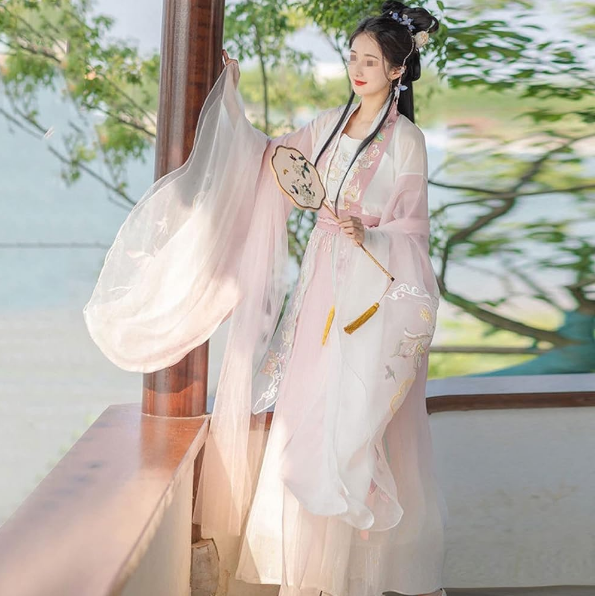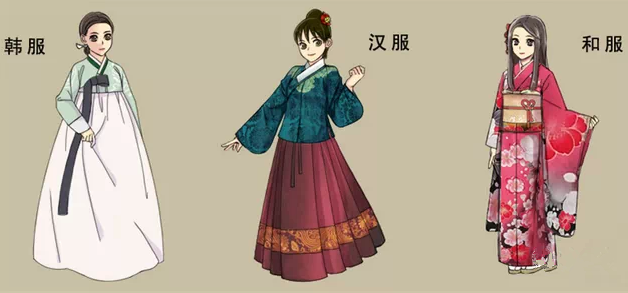Hanfu consists of a paofu robe, or a ru jacket worn as the upper garment with a qun skirt commonly worn as the lower garment. In addition to clothing, hanfu also includes several forms of accessories, such as headwear, footwear, belts, jewellery, yupei and handheld fans.
Defining Hanfu
Hanfu, a traditional Chinese attire, stands out with its unique aesthetic and historical significance. This attire, deeply rooted in Chinese culture, offers a glimpse into the rich tapestry of China’s past.
Key Features of Hanfu Clothing
Hanfu showcases distinct features that set it apart from other traditional garments. Firstly, its cross-collar design elegantly wraps around the body, symbolizing unity and modesty. The flowing sleeves of Hanfu, often wide and airy, add a sense of grace and poise. Fabric choice in Hanfu plays a critical role, with silk being the most revered for its smooth texture and luxurious appearance. Embroidery, another hallmark of Hanfu, often features motifs like dragons, phoenixes, and floral patterns, each with unique cultural connotations.

Different Types of Hanfu
Delving into the types of Hanfu, we find diverse styles reflecting different periods and social statuses. Shenyi, a one-piece robe, symbolizes the unity of heaven and earth, a core concept in ancient Chinese philosophy. The Ruqun, a versatile combination of a top and a wrap-around skirt, stands out for its adaptability and widespread use among women of various social classes. Zhiduo, typically worn by scholars, is characterized by its straight silhouette and simplicity, reflecting the wearer’s pursuit of knowledge and humility. Each type of Hanfu not only serves as a garment but also as a cultural artifact, telling stories of the era it represents.
Through this exploration of Hanfu, we not only understand its aesthetics but also appreciate its deep cultural roots and the stories woven into its fabric. This traditional attire, more than just clothing, is a living history of Chinese culture and aesthetics.
Components and Structure of Hanfu
Hanfu, the classical Chinese attire, presents a sophisticated structure that harmonizes form and function. This traditional wear reflects the ingenuity of ancient Chinese fashion, balancing elegance with comfort.
Upper Garments(Yi, Ao, Ru)
The upper garments of Hanfu, namely Yi, Ao, and Ru, serve as the foundational layers. Yi, a primary garment, typically features a cross-collar and is often made from fine materials like silk for added elegance. The Ao, a jacket-like overlay, provides additional warmth and style, often bearing intricate embroidery that symbolizes the wearer’s status. Ru, a lighter, more informal top, is perfect for everyday wear, reflecting the practical aspects of traditional Chinese clothing.
Lower Garments(Chang, Qun, Ku)
Moving to the lower garments, we find Chang, Qun, and Ku. Chang, a type of pants, offers comfort and ease of movement, a necessity in the daily lives of ancient Chinese people. The Qun, a skirt-like garment, ranges from simple designs for everyday wear to elaborate ones for special occasions, showcasing the versatility of Hanfu. Ku, narrow trousers, are often paired with longer upper garments, striking a balance between functionality and aesthetics.
In the intricate layers and diverse components of Hanfu, we witness a blend of practicality and artistry. This traditional attire is more than just a piece of clothing; it is a testament to the rich cultural heritage and the sophisticated textile craftsmanship of ancient China.
Hanfu Compared to Other Traditional Attires
Exploring the distinctive characteristics of Hanfu in comparison to other Asian traditional attires offers a fascinating insight into cultural differences and similarities.
Hanfu vs. Japanese Kimono
Hanfu and the Japanese Kimono share aesthetic beauty but differ in structure and symbolism. The Hanfu, known for its flowing silhouette and cross-collar, embodies the traditional Chinese aesthetic of harmony and fluidity. In contrast, the Kimono, with its T-shaped, straight-lined robes, represents the simplicity and refinement of Japanese culture. The use of obi (a sash) in Kimonos to cinch the waist contrasts with the usually loose fit of Hanfu. The fabrics and patterns of both attires often carry significant cultural meanings, reflecting the respective histories and philosophies of China and Japan.
Hanfu vs. Korean Hanbok
When comparing Hanfu with the Korean Hanbok, the differences in silhouette and color usage become apparent. The Hanbok, with its jeogori (a short jacket) and chima (a full skirt), creates a distinct silhouette that differs from the more uniform and layered appearance of Hanfu. Hanbok colors often symbolize social position and marital status, similar to how Hanfu uses embroidery and designs to signify status. Both attires use lightweight materials, but the styling and layering techniques showcase the unique fashion sensibilities of Korea and China.
| Feature | Hanfu | Japanese Kimono | Korean Hanbok |
|---|---|---|---|
| Structure | Cross-collar, flowing layers | T-shaped, straight-lined | Jeogori (jacket), Chima (skirt) |
| Symbolism | Harmony, fluidity | Simplicity, refinement | Social position, marital status |
| Material | Silk, light fabrics | Silk, cotton | Hemp, ramie, silk |
| Fit | Generally loose | Cinched with obi | Fitted jeogori, voluminous chima |
| Cultural Significance | Chinese history, philosophy | Japanese aesthetics, seasons | Korean social hierarchy, traditions |
Through these comparisons, we gain a deeper understanding of how traditional attires like Hanfu, Kimono, and Hanbok not only represent clothing but also embody the rich cultural heritages of their respective countries.

Cultural and Symbolic Aspects of Hanfu
Hanfu transcends mere clothing, embodying the depth and intricacy of Chinese culture. Each aspect of Hanfu, from its colors to its embroidery, carries rich symbolism and historical significance.
Hanfu in Traditional Chinese Festivals
During traditional Chinese festivals, Hanfu becomes a bridge connecting the present to the past. For instance, during the Lunar New Year, people often wear Hanfu adorned with auspicious symbols like dragons or phoenixes, which represent good fortune and prosperity. The Mid-Autumn Festival sees Hanfu in moon-like colors, embodying reunion and harmony. In the Dragon Boat Festival, Hanfu with boat and wave motifs becomes popular, symbolizing strength and perseverance.
Symbolism and Significance in Chinese Culture
Hanfu is steeped in symbolism. Colors in Hanfu, such as red for joy and good luck, and blue for immortality and peace, play a significant role in conveying cultural messages. The use of specific animals or nature elements in embroidery tells stories or conveys wishes: cranes for longevity, bamboo for resilience, and peonies for wealth and honor. The garment’s structure itself, particularly its flowing sleeves and cross-collar, represents traditional Chinese values of modesty and respect for nature.
Hanfu, thus, serves not just as attire but as a living canvas, capturing the essence of Chinese philosophies, traditions, and aesthetics. This deep connection with cultural roots makes Hanfu a timeless symbol of Chinese identity and heritage.







